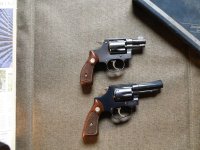FWIW, I wasn't a collector/accumulator until I found this community. I had a 640-1 for CC, a 29-6 Classic 6.5" for blastin', and a shooter grade pre-27 6.5" that was given to me when a dealer friend passed on ten years ago. After studying the SCSW, in 2008 I decided that prewar and transition period (1946-1949) N frames were my primary interest, the .44HE in particular. Why? Because they're big, classic revolvers and in some cases rare. Some of my S&W's are collectible with boxes and letters while others are worn and dinged but quite functional and enjoyable shooters.
Pre 1950
38/44 Outdoorsman prewar
38/44 HD prewar, transition
44HE 2nd Model
44HE 3rd Model prewar, transition
Along the way I broadened the scope to include pre models and certain models/features that just appeal to me. Apparently I really like tapered barrels and the Centennial:
Post 1950
Pre- 20 38/44 HD
Pre- 21 1950 Model 44 Military
Pre- 27 .357 Magnum 3.5" and 6.5"
Pre- 28 "Highway Patrolman 4"
24-3 "1950 .44 Target Reintroduction"
28-2 "Highway Patrolman" 4"
29-2 .44 Magnum Nickel 4"
29-5 .44 Magnum Blue 4"
29-6 "29 Classic" Blue 6.5"
624 "Model of 1985 .44 Target Stainless" 4"
629-2 "Mountain Revolver"
629-4 "Mountain Gun"
640-1 "Centennial" .357
642-1 "Centennial" .38
Admittedly there's not a lot of collecting discipline here but I do make an effort to look for N-frames 1935-1949 first, then pre-models, then interesting N-frames in top condition. I don't know which, if any, of the post-1960 production N frames are or will be deemed collectible, with the exception of rare "dash" engineering changes, reintroductions, and perhaps limited runs for Lew Horton, et. al. But it appears that at this moment the Model 27 and Model 28 are hot, pre-MIM is desirable. And, one should have a nickel 29-2 4" in a wooden display case, just 'cuz.
Attached pics are a few that have come my way.








